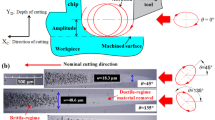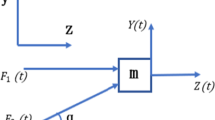Abstract
Chip and surface roughness (Ra) are the two main problems in ultra-precision machining. In the current research on elliptical vibration cutting (EVC), little is known about the impact of high-frequency tool tip ellipse trajectory deflection on the quality of cutting surfaces. In this paper, effective control of the tool tip ellipse trajectory deflection is achieved by adjusting phase difference. We also explain how tool tip ellipse trajectory changes affect chip and surface roughness. Firstly, an EVC device is optimized to obtain orthogonal vibration output of the tool tip based on the guided wave transmission technique. Secondly, we establish an elliptical trajectory deflection control model of the tool tip. Analysis of the control model shows that (1) when the tool tip amplitude and phase difference are simultaneously adjusted, the tool tip trajectory can be controlled at an angle of deflection with the same elliptical shape; (2) when only phase difference is adjusted, control of the tool tip trajectory is achieved at an angle of deflection with a different elliptical shape. At a phase difference below 90°, elliptical trajectory of the tool tip is considered positive, while at an angle exceeding 90°, the reverse is true. Analysis of cutting characteristics of the tool tip ellipse trajectory deflection controlled by phase difference adjustments and finite element simulation indicate that as the phase difference increases, the continuity of the chip and Ra first becomes better then poorer due to friction force reversal effect. At a phase difference of 60°, elliptical trajectory of the tool tip is positive with an appropriate dynamic plunging angle for optimized quality of the cutting surface. Overall, test results of our cutting experiment are consistent with theoretical reports demonstrating the feasibility and effectiveness of the current work.




















Similar content being viewed by others
Abbreviations
- Z :
-
Logarithm of impedance mode
- δ :
-
Impedance phase
- f :
-
Frequency
- P 1 :
-
Tool tip ellipse trajectory in the oxy plane
- P 2 :
-
Tool tip ellipse trajectory after deflection in the oxy plane
- \( {P}_1^{\prime } \) :
-
Tool tip ellipse trajectory in the o1x1y1 plane
- \( {P}_2^{\prime } \) :
-
Tool tip ellipse trajectory after deflection in the o1x1y1 plane
- η :
-
Deflection angle
- a :
-
Tool tip amplitude after deflection in x direction
- b :
-
Tool tip amplitude after deflection in y direction
- m :
-
Tool tip amplitude in x direction
- n :
-
Tool tip amplitude in y direction
- t :
-
Time
- θ :
-
Phase difference
- v :
-
Cutting speed
- x(t):
-
Displacement of tool tip ellipse trajectory in x direction
- y(t):
-
Displacement of tool tip ellipse trajectory in y direction
- x′(t):
-
Displacement in x direction after the tool tip ellipse trajectory deflects
- y′(t):
-
Displacement in y direction after the tool tip ellipse trajectory deflects
- β :
-
Phase difference after deflection
- R th1 :
-
Residual heights of the phase difference at 30°
- R th2 :
-
Residual heights of the phase difference at 60°
- R th3 :
-
Residual heights of the phase difference at 150°
- γ 1 :
-
Dynamic plunging angles of the tool rake face with phase difference at 30°
- γ 2 :
-
Dynamic plunging angles of the tool rake face with phase difference at 60°
- γ 3 :
-
Dynamic plunging angles of the tool rake face with phase difference at 150°
- Ra:
-
Surface roughness
References
Moriwaki T, Shamoto E (1991) Ultraprecision diamond turning of stainless steel by applying ultrasonic vibration. CIRP Ann 40(1):559–562. https://doi.org/10.1016/s0007-8506(07)62053-8
Shamoto E, Moriwaki T (1994) Study on elliptical vibration cutting. CIRP Ann 43(1):35–38. https://doi.org/10.1016/s0007-8506(07)62158-1
Lin GCI, Mathew P, Oxley PLB, Watson AR (1982) Predicting cutting forces for oblique machining condition. Proc Inst Mech Eng 196(1):141–148. https://doi.org/10.1243/pime_proc_1982_196_015_02
Shamoto E, Moriwaki T (1999) Ultaprecision diamond cutting of hardened steel by applying elliptical vibration cutting. CIRP Ann 48(1):441–444. https://doi.org/10.1016/s0007-8506(07)63222-3
Ma C, Shamoto E, Moriwaki T, Zhang Y, Wang L (2005) Suppression of burrs in turning with ultrasonic elliptical vibration cutting. Int J Mach Tools Manuf 45(11):1295–1300. https://doi.org/10.1016/j.ijmachtools.2005.01.011
Saito H, Jung H, Shamoto E, Wu TC, Chien JT (2017) Mirror surface machining of high-alloy steels by elliptical vibration cutting with single-crystalline diamond tools. Precis Eng 49:200–210. https://doi.org/10.1016/j.precisioneng.2017.02.008
He Y, Zou P, Zhu WL, Ehmann KF (2017) Ultrasonic elliptical vibration cutting of hard materials: simulation and experimental study. Int J Adv Manuf Technol 91(1–4):363–374. https://doi.org/10.1007/s00170-016-9716-8
Lu MM, Wang H, Guan L, Lin JQ, Gu Y, Chen B, Zhao DP (2018) Modeling and analysis of surface topography of Ti6Al4V alloy machining by elliptical vibration cutting. Int J Adv Manuf Technol 98:2759–2768. https://doi.org/10.1007/s00170-018-2452-5
Suzuki N, Masuda S, Haritani M, Shamoto E (2004) Ultraprecision micromachining of brittle materials by applying ultrasonic elliptical vibration cutting. Micro-Nanomechatronics and Human Science, Nagoya, Japan, IEEE Access https://doi.org/10.1109/MHS.2004.1421290
Xi X, Ding W, Li Z, Xu J (2017) High speed grinding of particulate reinforced titanium matrix composites using a monolayer brazed cubic boron nitride wheel. Int J Adv Manuf Technol 90(5–8):1529–1538. https://doi.org/10.1007/s00170-016-9493-4
Xiao G, Huang Y, Yin J (2017) An integrated polishing method for compressor blade surfaces. Int J Adv Manuf Technol 88(5–8):1723–1733. https://doi.org/10.1007/s00170-016-8891-y
Kim GD, Loh BG (2008) Characteristics of elliptical vibration cutting in micro-V grooving with variations in the elliptical cutting locus and excitation frequency. J Micromech Microeng 18(2):025002. https://doi.org/10.1088/0960-1317/18/2/025002
Kim GD, Loh BG (2011) Direct machining of micro patterns on nickel alloy and mold steel by vibration assisted cutting. Int J Precis Eng Manuf 12(4):583–588. https://doi.org/10.1007/s12541-011-0075-y
Suzuki N, Yokoi H, Shamoto E (2011) Micro/nano sculpturing of hardened steel by controlling vibration amplitude in elliptical vibration cutting. Precis Eng 35(1):44–50. https://doi.org/10.1016/j.precisioneng.2010.09.006
Zhang J, Suzuki N, Shamoto E (2013) Investigation on machining performance of amplitude control sculpturing method in elliptical vibration cutting. Procedia CIRP 8:328–333. https://doi.org/10.1016/j.procir.2013.06.111
Kim GD, Loh BG (2013) Cutting force variation with respect to tilt angle of trajectory in elliptical vibration V-grooving. Int J Precis Eng Manuf 14(10):1861–1864. https://doi.org/10.1007/s12541-013-0249-x
Kim GD, Loh BG (2009) Machining of micro-channels and pyramid patterns using elliptical vibration cutting. Int J Adv Manuf Technol 49(9-12):961–968. https://doi.org/10.1007/s00170-009-2451-7
Yang Y, Gao S, Chen K, Pan Y, Guo P (2017) Vibration analysis and development of an ultrasonic elliptical vibration tool based on a portal frame structure. Precis Eng 50:421–432. https://doi.org/10.1016/j.precisioneng.2017.06.016
Zhou M, Hu L (2015) Development of an innovative device for ultrasonic elliptical vibration cutting. Ultrasonics 60:76–81. https://doi.org/10.1016/j.ultras.2015.02.015
Moriwaki T, Shamoto E (1995) Ultrasonic elliptical vibration cutting. CIRP Ann 44(1):31–34. https://doi.org/10.1016/s0007-8506(07)62269-0
Suzuki N, Haritani M, Yang J, Hino R, Shamoto E (2007) Elliptical vibration cutting of tungsten alloy molds for optical glass parts. CIRP Ann 56(1):127–130. https://doi.org/10.1016/j.cirp.2007.05.032
Guo P, Ehmann KF (2013) Development of a tertiary motion generator for elliptical vibration texturing. Precis Eng 37(2):364–371. https://doi.org/10.1016/j.precisioneng.2012.10.005
Yu DP, Zhang M, Huang WH, Liu JG, Yao J, Chen DS (2018) Design of a device for ultrasonic vibration cutting based on the finite element method. Adv Eng Sci 50(2):170–176
Huang ZP, Pi J, Yang G (2019) Realization of two dimensional high frequency ultrasonic vibration using guided wave transmission. Mech Sci Technol Aerosp Eng 38(2):230–236
Jiang YA, Pi J, Yang G, Jiang T, Shen ZH (2019) Influence of ultrasonic elliptical vibration cutting trajectory change on surface morphology. Acta Armamentarii 40(10):2170–2176
Yang G, Pi J, Liu ZS (2017) Non-physical sharpening of cutting edge induced by the joint-use of ultrasonic vibration and cutting fluid in metal-cutting. J Mech Eng 53(19):100. https://doi.org/10.3901/jme.2017.19.100
Dai H, Chen J, Liu G (2019) A numerical study on subsurface quality and material removal during ultrasonic vibration assisted cutting of monocrystalline silicon by molecular dynamics simulation. Mater Res Express 6(6). https://doi.org/10.1088/2053-1591/ab0ccb
Pi J, Xu XP (2010) Hydrodynamic pressure oil film modeling and experimental study of ultrasonic vibration cutting. Chin J Mech Eng 46(7):175–180
Funding
This work was supported by the Natural Science Foundation of Fujian Province (project number: 2017J01700) and the Science and Technology Key Project of Fujian Province (project number: 2017H0025). The authors would also like to thank Prof. Qihui Wu for his contribution to the improvement of the language.
Author information
Authors and Affiliations
Corresponding author
Additional information
Publisher’s note
Springer Nature remains neutral with regard to jurisdictional claims in published maps and institutional affiliations.
Rights and permissions
About this article
Cite this article
Jiang, Y., Pi, J., Zhang, Y. et al. Research on the tool tip trajectory deflection control and cutting characteristics of elliptical vibration cutting based on guided wave transmission. Int J Adv Manuf Technol 108, 3101–3117 (2020). https://doi.org/10.1007/s00170-020-05552-y
Received:
Accepted:
Published:
Issue Date:
DOI: https://doi.org/10.1007/s00170-020-05552-y




